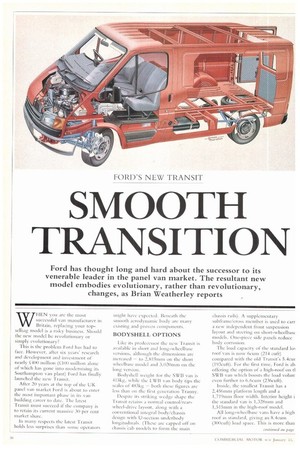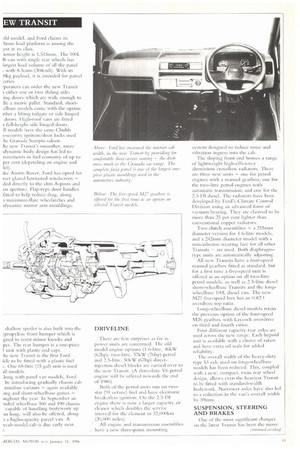SMOOTH TRANSITION
Page 38

Page 43

Page 44

If you've noticed an error in this article please click here to report it so we can fix it.
Ford has thought long and hard about the successor to its venerable leader in the panel van market. The resultant new model embodies evolutionary, rather than revolutionary, changes, as Brian Weatherley reports
WIIEN you are the most successful van manufacturer in Britain, replacing your topselling model is a risky business. Should the new model be revolutionary or simply evolutionary?
This is the problem Ford has had to face. However, after six years' research and development and investment of nearly 4I 1) million (1:100 million alone of which has gone into modernising its Southainpton van plant) Ford has finally launched the new Transit.
After 20 years at the top of the UK panel van market Ford is about to enter the most important phase in its van building career to date. The latest Transit must succeed if the.company is to retain its current massive 30 per cent market share.
In many respects the latest Transit holds less surprises than some operators might have expected. Beneath the smooth aerodynamic body are many existing and proven components.
BODYSHELL OPTIONS
Like its predecessor the new Transit is available in short and long-wheelbase versions, although the dimensions are increased — to 2,815min on the short wheelbase model and 3,020min on the long version.
Bodyshell weight for the SWB van is 415kg, while the LW B van body tips the scales of 483kg — both these figures arc less than cm the first generation Tranny.
Despite its striking wedge shape the Transit retains a normal control/rearwheel-drive layout, along with a conventional integral body/chassis design with U-section underbody longitudinals. (These are capped off on chassis 'cab models to tOrm the main chassis rails). A supplementary subframe/cross member is used to carr a new independent front suspension layout and steering on short-wheelbasc models. One-piece side pallets reduce body corrosion.
The load capacity of the standard lco roof van is now 6cum (214 cult) compared with the old Transit's 5.4cm (193ctift). For the first time. Ford is als offering the option of a high-roof on tl SWB van which boosts the load volurr even further to 6.6cum (236cult).
Inside, the smallest Transit has a 2,456nun platform length and a 1,719min floor width. Interior height i the standard van is 1,328mm and 1,515min in the high-roof model.
All long-wheelbase vans have a high roof as standard, giving an 8.4cum (300cult) load space. This is more than Ad model, and Ford claims its 5nini load platform is among the ;est in its class.
tenor height is 1,515mtn. The 100L B van with single rear wheels has largest load volume of all the panel ; with 8.5cum (304cult). With its 10kg payload, it is intended for parcel veries.
perators can order the new Transit either one or two sliding sideMg doors which are wide enough to ile a metric pallet. Standard, shortelbase models conic with the option idler a lifting tailgate or side hinged doors. I ligh-roof vans are fitted full-height side hinged doors. 11 models have the same C:huhb 1-security ignition/door locks used he Granada Scorpio saloon.
he new Transit's smoother, more dynamic body design has led to rovements in fuel economy of up to per cent (depending on engine and lel).
ike Austin Rover, Ford has opted for rect glazed laminated windscreen — ded directly to the slim A-posts and en aperture. Flap-type door handles fitted to help reduce drag, along minimum-flare wheelarches and idynamic mirror arm mouldings.
shallow spoiler is also built into the ;propylene front bumper which is gned to resist minor knocks and pcs. The rear bumper is a one-piece 1 unit with plastic end caps.
he new Transit is the first Ford icle to be fitted with a plastic fuel :. One 6g-litre (15 gal) unit is used ill models.
,long with panel van models, Ford be introducing gradually chassis cab minibus variants — again available png and short-wheelbase guises — iughour the year. In September an .ricled wheelbase 160 and 190 chassis capable of handling bodywork up -in long, will also be offered, along .1 a high-capacity parcel van. A vcab model cab is due early next r. A ho '1' Ford has ininraSed the interior cab width, in the nen, Transit by providing for comfortable three-across sedans; — the dash owes ifillfil /0 the Granada tar range. The complete jacia panel is 01 U' of the !awes/ onepiece plastic mouldinqs used in the automotive industry.
There are few surprises as far as power units are concerned. The old model engine options (1.6-litre, 46kW (62hp), two-litre, 57k W (76hp) petrol and 2.5-litre, 50kW (67hp) directinjection diesel blocks an. carried over to the new Transit. (A three-litre V6 petrol engine will be offered towards the end of 1986).
Both of the petrol units run on twostar (91 octane) fuel and have electronic brc.'akc.Tless ignition. On die 2.5 1)1 engine there is now a larger capacity air cleaner which doubles the service interval for the clement to 32,0)0kni (20,000 miles).
All engine and transmission assemblies have a new three-point mounting system designed to reduce noise and vibration ingress into the cab.
The sloping front end houses a range of lightweight high-efficiency aluminium crossflow radiators. There are three new units — one for petrol engines with a manual gearbox; one for the two-litre petrol engines with automatic transmission; and one for the 2.5 1)1 diesel. The radiators have been developed by Ford's Climate Control Division using an advanced form of vacuum brazing. They are claimed to be more than 25 per cent lighter than conventional copper radiators.
Two clutch assemblies — a 215min diameter version for 1.6-litre models, and a 242nun diameter model with a non-asbestos wearing face for all other Transits — are used. Both diaphragmtype units are automatically adjusting.
All new Transits have a four-speed manual gearbox fitted as standard, but for a first ttille a five-speed unit is offered as an option on all two-litre petrol models, as well as 2.5-litre diesel short-wheelbase Transits and the longwheelbase 100L diesel van. The new M27 five-speed box has an 0.82:I overdrive top ratio.
Long-wheelbase diesel models retain the previous option of the four-speed M26 gearbox with Laycock overdrive on third and fourth ratios.
Four ditferent capacity rear axles are used across the new range. Each hypoid unit is available with a choice of ratios and have extra oil seals for added The overall width of the heavy-duty type 53 axle used on long-wheelbase models has been reduced. This, coupled with a new, compact, twin rear wheel design, allows even the heaviest Transit to be fitted with standard-width bodywork. Narrower axles have also led to a reduction in the van's overall width by 59nun.
SUSPENSION, STEERING AND BRAKES
One of the most significant changes on the latest Transit has been the move away from leaf springs on the front axle of all short-wheelbase models to a new independent Macpherson strut layout.
The inclined Macpherson strut acts as the damper, while the coil spring (which normally surrounds the damper in a conventional Macpherson strut arrangement) is positioned in-board between a pressed steel wishbone and the subframe which carries the suspension and steering gear.
The separate mounting of the front coil spring reduces the suspension intrusion into the lootwell.
To reduce the transfer of road noise on SWB models Ford tits insulating bushes in the inner wishbone joints and the top end of the Macpherson struts, lii addition, the coil spring is separated from the cross member by a rubber pad and a rubber bump stop.
Short-wheelbase models have a conventional leaf spring arrangement on the rear axle, while long-wheelbase models retain an I-beam front-axle design with leaf springs all-round, similar to the old Transit model.
Rack-and-pinion steering box is fitted to all short-wheelbase models for the first time. This reduces turning efforts significantly and makes the tight 10.5m (between kerbs) turning circle fully useable, according to Ford.
The old Transit's front-disc and rear drum braking system has been improved on the new model. Front pad area and volume and rear lining volume are increased by 40 per cent over the original Transit to give better wear rates. Changes to the brake booster and pedal layout have also made it easier to control the brake eftbrt, giving the driver greater brake feel. The front brakes have non-asbestos pads.






















































